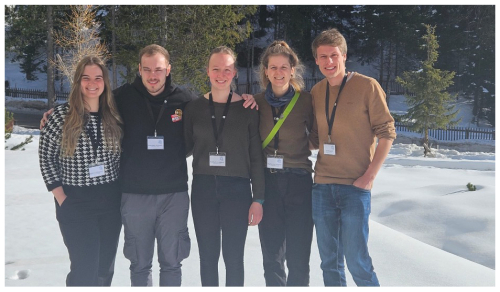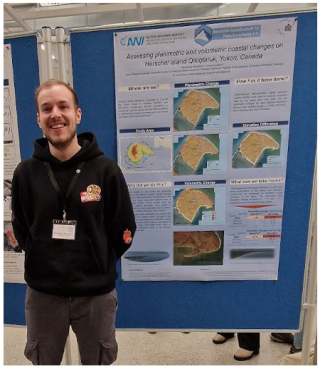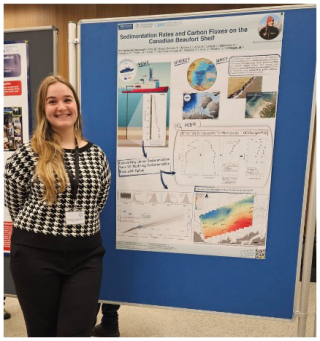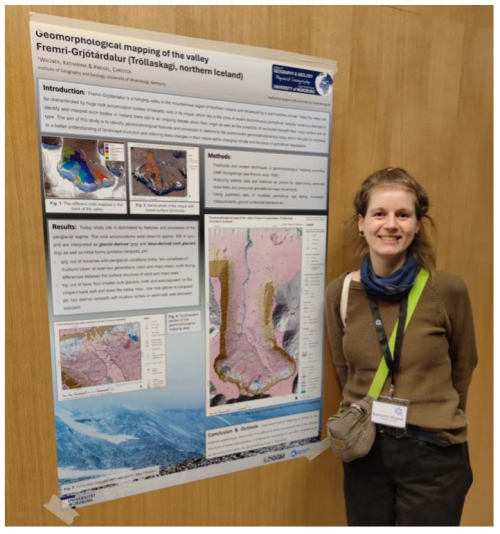Early-career researchers at the 15th DACH Permafrost Conference
Katharina Schwarzkopf
Katharina Jaspers
Maximilian Rometsch
Katharina Wagner
Tim Wiegand
In January 2025, for the 15th time, the DACH Permafrost Union (Arbeitskreis Permafrost) held its regular conference. Hosted by the WSL Institute for Snow and Avalanche Research (SLF), the 3 d event in Davos, Switzerland, brought together scientists working on polar and mountain permafrost. The large number of participants, and especially of young researchers, reflects the importance of the DACH Permafrost Conference, not just due to the various scientific contributions but also for workshops, field trips, and social gatherings. Five early-career scientists received financial support from the German Society of Polar Research (DGP) to present their projects and outcomes as posters and talks and to exchange with the broad permafrost community.
- Article
(2192 KB) - Full-text XML
- BibTeX
- EndNote
The DACH Permafrost Conference is an annual gathering of researchers specializing in permafrost studies, primarily from the three DACH countries Germany, Austria, and Switzerland. The conference serves as a platform to foster scientific exchange across diverse research topics and groups, as well as to promote collaboration among researchers in different career stages, including senior scientists, postdocs, and PhD and undergrad students. This year's DACH Permafrost Conference was held in Davos, Switzerland, from 8–10 January 2025. The event was organized by the SLF Permafrost Research Group (WSL Institute for Snow and Avalanche Research, Davos). Its overarching topics included alpine permafrost, data management, and polar permafrost. Over the course of 3 conference days, 35 talks and 41 posters were presented to more than 90 participants (Fig. 1), including 33 early-career researchers (ECRs). Contributions, for example, about polar greenhouse gas emissions, pollution of Arctic permafrost regions, Alpine rock-slope instabilities, or mountain rock glacier dynamics document the need to study the wide impacts of climate change on permafrost-affected areas.
The conference included a workshop for young researchers on data management, a meeting of the GTN-P (Global Terrestrial Network on Permafrost), and an ice-breaker event on the first day. These activities were followed by a day and a half of scientific sessions. Participants also had the opportunity to learn about the work of the SLF during a guided tour through the institute and its laboratories. Since the talks were not split into different blocks taking place in parallel, the attendees did not have to choose between topics but were able to listen to all presentations. For a comprehensive overview of the topics covered during the conference talks, please refer to the abstract collection by Weber (2025).
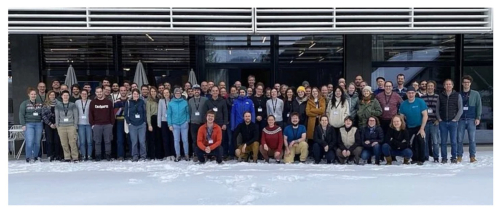
Figure 1Group picture of the participants of the 15th DACH Permafrost Conference in Davos, Switzerland (photo source: https://www.slf.ch/de/veranstaltungen-und-kurse/dach-permafrost-conference, last access: 14 January 2025).
The conference program in Davos, Switzerland, comprised a wide range of interesting activities. Highlights included a workshop for ECRs, an ice-breaker event with traditional Swiss cheese fondue, an excursion to the Swiss Alps, a guided tour through the SLF, and other social events that encouraged networking and scientific discussions. ECRs were strongly represented and made an important contribution with their presentations and posters. Many of these researchers, including members of the Permafrost Young Researchers Network (PYRN), presented their work, highlighting the inclusive and collaborative nature of the permafrost research community. The PYRN data management workshop on the first day provided a lively platform for knowledge exchange and professional development. The choice of Davos as the venue gave the event a very special charm. Known for its snowy landscapes, the World Economic Forum, and ski tourism, Davos offered a cozy, cottage-like atmosphere.
The German Society for Polar Research (Deutsche Gesellschaft für Polarforschung, DGP) supported five ECRs from the Alfred Wegener Institute, the Helmholtz Centre for Polar and Marine Research, the Julius Maximilian University of Würzburg, and Stockholm University to attend the DACH Permafrost Conference in Davos (Fig. 2). In the following, we briefly describe the individual scientific contributions to the conference.
3.1 Katharina Jaspers
Katharina Jaspers presented preliminary results of her master's thesis on “Quantifying mercury (Hg) release from coastal erosion along the Yukon coast, Canada” (Fig. 3). Using sediment samples from a retrogressive thaw slump (a landslide feature driven by permafrost thaw), she had a look at the Hg distribution within the slump and provided insights into the fate of Hg once introduced into the Arctic Ocean. Her analysis revealed a Hg release of 683.3±185.7 g yr−1 from the thaw slump, which corresponds to approximately 1 % of the total Hg released from the small island Herschel Island Qikiqtaruk (Yukon, Canada) on which the slump is located.
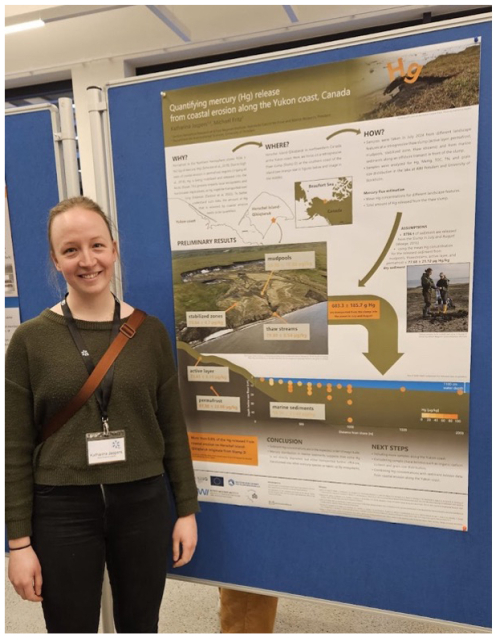
Figure 3Katharina Jaspers in front of her poster “Quantifying mercury (Hg) release from coastal erosion along the Yukon coast, Canada”.
3.2 Maximilian Rometsch
Maximilian Rometsch presented the preliminary results of his master's thesis project on “Assessing planimetric and volumetric coastal changes on Herschel Island Qikiqtaruk, Yukon, Canada” (Fig. 4). His work was shown during the only poster session of the conference and gave insights into the changes of the coastline on Herschel Island Qikiqtaruk (HIQ; formerly known as Herschel Island). His research is aimed to connect the planimetric (2D) and volumetric (3D) coastal erosion measurements on the island and served as an update of coastal erosion rates in the most recent years. Lidar-derived high-resolution digital elevation models (DEMs) were used to compute volumetric data for the years 2013 and 2023. For the planimetric changes, digitized coastlines derived from satellite imagery in 2000, 2011, and 2022 were used. The results shown at the DACH Permafrost Conference 2025 focused on the most recent increase in erosion rates on HIQ and the resulting large implications for the near-shore ecosystems and extensive impacts on settlement on the island in the future.
3.3 Katharina Schwarzkopf
Katharina Schwarzkopf presented part of her PhD research on sedimentation rates, carbon fluxes, and burial processes on the Canadian Beaufort Shelf, highlighting the challenges of estimating permafrost carbon burial due to limited modern sedimentation data (Fig. 5). Using 25 sediment cores taken in the fall of 2021, measurements of total organic carbon, 210Pb, 214Pb, 137Cs, and grain density were made to calculate sedimentation rates and organic carbon fluxes. The results were compared with existing data from the CASCADE database and seismic records of Holocene sediments to answer important questions about spatial variability and the accuracy of long-term estimates related to climate change.
3.4 Katharina Wagner
Katharina Wagner presented her bachelor's thesis on “Geomorphological mapping of the valley Fremri-Grjótárdalur in Tröllaskagi, Northern Iceland” (Fig. 6). Through detailed geomorphological mapping, she identified several rock glaciers, which are classified as both talus- and glacier-derived. The latter formed larger, more complex structures composed of different units. Furthermore, she hypothesized the existence of molards – small mounds of melted sediments associated with permafrost degradation. Due to the method's limitation to the external appearance, the application of other methods such as geophysics is necessary to verify the assumptions made in this study.
3.5 Tim Wiegand
As the final talk of the conference, Tim presented “Geoelectrical investigations of pingos and related permafrost mounds in the Ogilvie Mountains, northwestern Canada”, results of the ongoing project “Pingo 3D” (Fig. 7). Using electrical resistivity tomography, the interior, surrounding, and hydrological connection of pingos, conspicuous dome-shaped permafrost hill forms, were studied. The generated high-resolution subsurface models revealed complex structures including massive ice cores but also unfrozen zones that can serve as water pathways. The talk concluded with an overview of recent research activities in lowland areas of the Tuktoyaktuk peninsula, known as the “land of the pingos”.
Participating in the DACH Permafrost Conference was an enriching and meaningful experience for all of us. It was an excellent opportunity to present our own findings to an international audience and to receive valuable feedback, fresh perspectives, and diverse opinions on our research. Equally important was the chance to connect with new people in the field of permafrost research and to begin establishing our own network within the permafrost community.
The data and code presented in this report are part of ongoing and/or unpublished projects and are not publicly available at this time. Further details are available from the individual authors upon reasonable request.
Each author prepared and wrote the section related to their individual project. The remaining parts of the report were written jointly with contributions from all authors. KS coordinated the manuscript preparation, organized the overall structure, and managed correspondence.
The contact author has declared that none of the authors has any competing interests.
Publisher's note: Copernicus Publications remains neutral with regard to jurisdictional claims made in the text, published maps, institutional affiliations, or any other geographical representation in this paper. While Copernicus Publications makes every effort to include appropriate place names, the final responsibility lies with the authors.
We would like to express our gratitude to the DGP, the Bolin Centre for Climate Research at Stockholm University, the German Research Foundation, and the Central Equal Opportunity Office of the University of Potsdam for their funding, which made the attendance of the DACH conference possible. Their generous financial support enabled us to participate in this scientific event and contribute to the advancement of permafrost research. We would also like to thank the local organizing committee and WSL Institute for Snow and Avalanche Research SLF for their dedicated efforts in organizing a successful conference in Davos.
Weber, S. (Ed.): 15th DACH permafrost conference – abstract collection, Swiss Federal Institute for Forest, Snow and Landscape Research WSL, Davos, Switzerland, 80 pp., https://doi.org/10.55419/wsl:38238, 2025.





